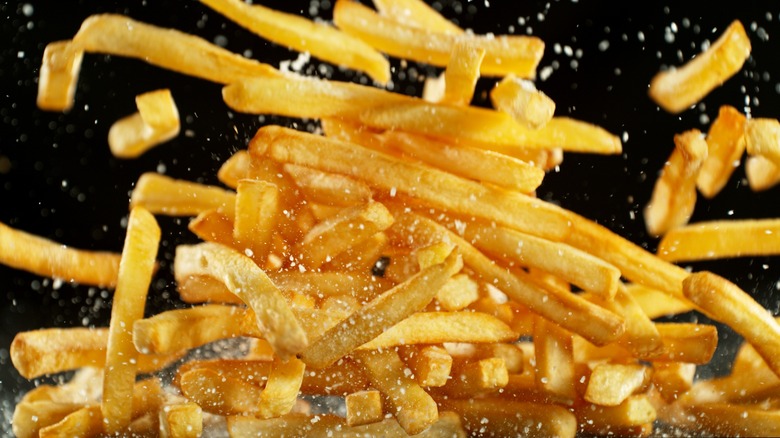Totally Elevate The Texture Of French Fries With A Quick Blanch
If you're someone who makes french fries from scratch at home, you've probably noticed they often turn out a little lacking. Lacking the desired crispiness on the outside and the ever-important fluffiness on the inside. Lacking the right golden color as they edge toward an almost burnt shade of dark brown. And finally, lacking staying power as they get progressively soggier over time. Fortunately, there is a way to fix these problems and ensure that your homemade french fries come out perfect every single time. You'll never have to worry about failing to achieve just the right texture as long as you follow this one step.
What is this mystery step? It all boils down to, well, a brief boil. Also known as blanching — that first stop in hot water is how fast food restaurants guarantee that their fries turn out simultaneously crispy and fluffy with the perfect golden exterior. Paired with a couple of other key tips, you can ensure that the fries coming out of your kitchen are just as good as those from your favorite drive-thru.
Why fries should always be blanched first thing
There's a good reason why blanching should always be your first step when cooking fries from scratch. Without getting too heavily into the science, doing so basically changes the enzyme process within the fries, and that results in the texture that you're after, both inside and outside. Additionally, blanching removes the extra sugar that would otherwise give them that overly dark brown color. This is the same concept as soaking them in cold water beforehand, but more effective since it also cooks the interior and prepares the exterior for frying.
It's also quick and easy to do. Just toss your sliced potatoes into a pot of cold water on the stove. From there bring the water to a boil, keeping a careful eye on it so that you know when to start the timer. This is important to avoid overcooking as doing so will result in a disappointing mush that no amount of frying can save. A little vinegar in the water can help the potatoes remain firm enough. Five minutes is plenty of time to cook the sliced potatoes through the center, purge the excess sugars, and get the enzymes to cooperate, while also maintaining their shape and integrity. After that, you'll want to drain and dry the fries. This is an important step to avoid any splattering during the next part — the frying.
Double fry for the best results
While blanching fries first is the best way to get their texture right, you'll also want to fry them twice to achieve that restaurant quality. The first frying is essentially another stage of pre-cooking. It will ensure the fries are soft and pillowy in the center before they start to crisp up on the outside. This is important because fries that aren't all the way done in the middle first will end up with a hard, crunchy exterior instead of a perfectly crisp one. For the first frying, heat the oil to 400 degrees Fahrenheit and cook the fries for just 50 seconds.
The fries won't be golden after the first trip into the oil. If they are, you've cooked them too long. The second frying is what will produce the ideal golden color. The fries should be completely cooled in between the first and second frying. And, if you want, you can even freeze them like restaurants do. This will improve their texture even more. For the second round, heat the oil back up to 400 degrees and fry for another three and a half minutes.
Keep in mind that you may need to adjust timing and temperature if your fries are thinner or thicker than a standard ¼ inch. Ultimately, the most important thing is remembering to give them a quick blanch followed by a double frying, and you won't be disappointed.


